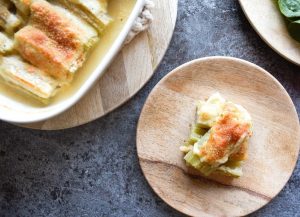What came to your mind when you first time heard the word Cardone vegetable? Isn’t it a Weird Name?
First time I heard about this vegetable from my friend Billy. One day he came to me and said he tried a new delicious vegetable dish made by his Moroccan friend. He told me the name of the vegetable is Cardone!
And the first thing that came to mind is what the hack it is? After all, it got a funny name to say out loud. So, I found it very interesting and started research on this, and it did not stop there. I tried one of the Cardone recipes, and the taste was delicious.
So let me share some surprising facts about this Cardone vegetable. Also, I will share a delicious recipe that you can try at home.
What is Cardone Vegetable?
It is popularly known as artichoke thistle, and it belongs to the sunflower family. Naturally grown wild plants are found in the central Mediterranean region and grow in dry climates. It is also a native plant across Morocco, Portugal, Libya, and Cyprus. Cardone is closely related to artichoke and is cultivated in many forms. There are so many things in common between them, including their physical structure.
Both of them produce a thistle-like flower; even the color of the flowers is the same too.
One of the vital differences I found between the artichoke and Cardone is that a Cardone vegetable has a bitter taste than a globe artichoke. Cardone is also used as a celery substitute because the stems look identical to celery.
The stalks are the only edible part. The flower buds are not editable at all. Additionally, and it is a common ingredient used in many Italian dishes. It was popular in Persian, ancient Greek cuisine with its thistle-like flower.
About Cardone Plant
Nowadays, it’s cultivating in some places in Europe and a food source. the planting time is in January- February and the harvest is in May when it’s spring.
The cultivation process starts from indoor planting when the seed is planted in a small pot and then transferred into the garden. In the very first year, you will discover a large single Vass shape rosette produced by the plant. The leaves become silver covering with tiny hairs and turn grey eventually.
Warm and sunny weather is essential for growing this plant. Also, there needs some free space that will help the stalks to extend freely. Wet soil may cause the plant to die, especially in the winter. It takes almost 2-3 years for the plant to gain a real presence. The stalks get matured at the age of 3, so only after the time, you can harvest the stalk.
To maintain a vase shape, you need to trim off the plant regularly by cutting off the old leaves.
The growing process is quite expensive and highly labor-intensive. When you are growing this plant for commercial purposes, it needs to be bleached. Blanched is a way to keep the plant away from the sunlight to prevent photosynthesis and chlorophyll production. Thus the color remains intact and natural. Also, it makes the Cardone vegetable easier to cook.
7 Best Ways To Enjoy Cardone:
The preparation of Cardone vegetables is also not easy; there is a need for a lot of work to get a small reward. You can hardly get 2 pounds of stalks from around 5-6 pounds of Cardone. Also, the stalk skin has hard ridges, so you must peel them off before cooking. For better safety, you can use hand gloves, or you can also use a vegetable peeler. For some recipes, it requires soaking it for almost an hour. But all the hard works paid off because of its taste. Delicious.
1. Make Some Fry From It:
It is one of the most standard and straightforward ways. Peel the skin off and cut the stalks into 2-3 small pieces. Soak them into water. If you do have not enough time in hand, you can process the whole thing the day before and store it in the fridge. It may need at least 30 min to 1 hour or sometimes more than that, based on the recipe requirement.
Water helps to make it tender as it’s a sturdy veggie. I believe processing is the hardest part. Once the processing part is complete, then the rest is not that time-consuming. What you need to do now is fry them, the frying process is so simple and most likely the way we sear anything. Fry until it turns a little brown.
2. Try Eating Raw:
After peeling off the hard ridge or skin, you will get the edible stalk. But the bitter taste is still there. You can eat this raw as a snack, just like celery. Use sauce or butter for dipping. There are many Italian dishes out there, where this ingredient is used as a dipping item, and one of the famous ones is Bagna cauda. The Cardone needs to boil in the water until it gets tender, then it’s dipped into the sauce.
3. Use It To Make Cheese:
Its flower buds are so popular in the southern part of Italy. In some other countries like Spain and Portugal, flower buds have a usage in making cheese. The flower pistols contain an enzyme that helps to make the cheese. Some famous cheese is Torta del Casar cheeses in Spain or the Serra da Estrela cheeses in Portugal.
4. Braised Cooking:
Cardone vegetable stems are mostly eaten after being braised. Braising is a popular cooking method. In this process, the dish is first seared at a high temperature and then cooked in a covered-up pot in moderate heat with a variable amount of cooking liquid. The lightly braised stalk can be used in chicken broth and parsley.
5. Use It In Soup Or Stew:
It needs a lot of soaking for Cardone to make it tender before you cook it as it is a fibrous plant. Caroon is also a popular substitute for celery, so if there are any dishes where celery is used, you can use it too
A slow cooker works best to prepare this. Preparing a dish with Cardone vegetables Is time-consuming while soaking it into the water; after half an hour, you can add meat or other veggies that you want with seasoning. If you do not have a slow cooker, boil it and make a puree and use the puree in the soup or desired dishes.
6. Texture For Tuna Or Chicken Salad:
Cardone adds a nice texture to a Tuna or chicken salad. Clean and trim the stocks and chop them into pieces. Mix the chopped stocks with mayonnaise or mastered and chicken or Tuna. You can serve this over the wheat bread. To increase the taste, add a little bit of hot sauce.
7. Brining Cardone:
Another great way to eat is to brine them. Brining is the solution of water and salt with an optimum ratio. It Brings a unique, balanced salty taste to the food. Cut the stokes into small pieces and drop them into a brine of 1/4 cup of cooking salt to 1 liter of water for up to 7 to 12 days, and they will turn into fermented Cardone. I love the process because it’s so easy to make, time saver, and tasty too.
All the cooking methods I mentioned above are excellent, and each of them has its uniqueness. But, now, I will share my most favorite way of cooking it. Because this dish is unique, classic, tasty, and, most importantly, you will never be bored with its taste.
Cardone Recipe: Cardone Gratin, Italian Style
Processing:
Please ensure that the stocks are well-trimmed, soaked into water, then peeled and cooked minimum for 1 hour before incorporating it into the dish.
This recipe is adapted from one of Mario Batali’s recipes.
Cooking Time:
1 Hour-1.30 Hour
Serving:
4 People
For The Cardone Vegetable:
- Five well-grown and mature stalks
- One lemon
Sauce Ingredients:
- Three tablespoons of unsalted butter
- Two tablespoons of flour
- 1.5 cups milk
- salt as per your taste and standard is one teaspoon.
- Black pepper powder
- About 1/2 teaspoon Cinnamon powder
For The Decoration:
- One cup grated Parmesan cheese.
- 1 cup bread crumbs
Processing :
- Use fresh Cardone if you can. Trim it thoroughly, remove all the leaves, outer fibrous ribs, white fuzz, etc. So, now the edible stems are left. Soak them into the water in a jar for 30 min.
- Take a large pot and fill the two-third of the pot with water and then squeeze lemon slices into the water.
- Cut the peeled stocks into small pieces 3 to 5 inches long, put them into the pot, and boil it with initial high heat until then with medium heat until It becomes tender. It may take a max of 1 to 1.30 hours. When done, take them out and rinse.
- Take a large oven-proof casserole and preheat your oven to 370 degrees.
Making The Sauce:
- Take a saucepan and melt the butter with medium heat. Add Two tablespoons of flour and stir it to mix it well. It may take 5 minutes to turn the mixture into brown color.
- Now it’s time to add milk to it, and you have to keep stirring the whole time so that it does not burn, and the mixture gets a smooth texture.
- After a few minutes, you will notice some bubbling around the mixture, lower the heat, do stirring often, and take it off from the heat after 8-10 minutes.
- Mix the nuts, cinema, salt, and pepper, and mix it well.
Final Finishing:
Put the Cardone pieces in the casserole in an organized way and then cover them up with the sauce you just made. Sprinkle some bread crumbs and parmesan cheese. Now, bake it for another 30 min until it gets a golden brown.
Now it’s all ready to eat.
Conclusion
At the final point, I want to say Cardone is a fantastic vegetable a cooking enthusiast must try. It is such a plant that not only provides you the food but also enhances your garden’s beauty.
You can not ignore its beautiful-looking flowers and silvery leaves. I agree that making a Cardone vegetable dish is time-consuming work, but it’s worth it. Its delicious taste will make you fall in love with it. Do try it and experience something new.


